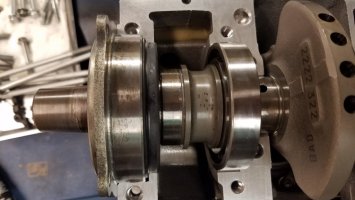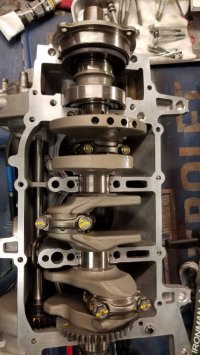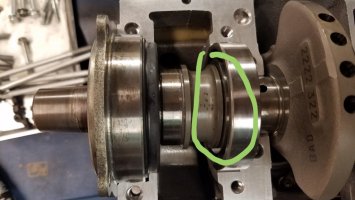

STAIN
Lifetime Member
- Joined
- Feb 29, 2004
- Messages
- 4,392
- Reaction score
- 3,669
- Points
- 1,713
- Location
- Vermont
- Country
- USA
- Snowmobile
- 2024 Arctic Cat Riot 9000
- LOCATION
- Vermont
That makes sense then.as you have it now its stretched over where it actually rides
I was assuming it rode on the rearward race
Sevey
TY 4 Stroke God
- Joined
- Feb 15, 2011
- Messages
- 1,787
- Reaction score
- 620
- Points
- 1,228
- Location
- Collingwood, ON
- Website
- www.ty4stroke.com
- Country
- Canada
- Snowmobile
- 2018 Sidewinder RTX
It has to be pressed on in the proper order. Make sure the orientation of the seal is correct as its magnetic (dont put it on backwards).How are people getting the inner seal properly installed during shaft installation?
Just stuffing the whole assembly in does not seem like it would go far enough to install the inner seal properly, or if the seal does go in it would not ride on the shaft properly?
Am I missing something? Does it matter?
I have the shaft out, and looking at it, it seems as though the shaft has to be installed first, install the seal, then the bearing after.
If my memory serves me - i used two 1/2" plates when reassembling to sandwich things when putting on.
MS
Sevey
TY 4 Stroke God
- Joined
- Feb 15, 2011
- Messages
- 1,787
- Reaction score
- 620
- Points
- 1,228
- Location
- Collingwood, ON
- Website
- www.ty4stroke.com
- Country
- Canada
- Snowmobile
- 2018 Sidewinder RTX
Also -when reinstalling, I pressed the bearing into the housing. Then pressed the housing (with bearing) onto the shaft.
MS
MS


Turboflash
Lifetime Member
- Joined
- Mar 18, 2019
- Messages
- 2,756
- Reaction score
- 2,797
- Points
- 1,113
- Location
- Southern MN
- Country
- USA
- Snowmobile
- '17 ZR9000 Ltd. 137 - PEFI Stage 4

KnappAttack
24X ISR World Drag Racing Champion
- Joined
- Feb 19, 2004
- Messages
- 4,847
- Reaction score
- 6,112
- Points
- 1,733
- Location
- Welch MN
- Country
- USA
- Snowmobile
- 2023 Sidewinder LTX-LE
2017 Sidewinder LTX-LE
Here's how it looks installed.
I'm going to rob this picture and use it in the other thread about that knockout kit. This is how I remember the shaft went into the internal bearing. So I figured I was remembering it correctly. Thanks for that Turboflash!
Sevey
TY 4 Stroke God
- Joined
- Feb 15, 2011
- Messages
- 1,787
- Reaction score
- 620
- Points
- 1,228
- Location
- Collingwood, ON
- Website
- www.ty4stroke.com
- Country
- Canada
- Snowmobile
- 2018 Sidewinder RTX
Love the pic
MS
MS


Turboflash
Lifetime Member
- Joined
- Mar 18, 2019
- Messages
- 2,756
- Reaction score
- 2,797
- Points
- 1,113
- Location
- Southern MN
- Country
- USA
- Snowmobile
- '17 ZR9000 Ltd. 137 - PEFI Stage 4
Correct. Crank end of stub goes into the ID of that ball bearing. That ball bearing only supports stub, not crank. Crank has a main bearing right next to that ball bearing.
Another clever design feature of this is that no matter what you do with stub assy, you cannot preload the crank. The worst that can happen (if you only partially install the stub shaft into outer bearing) is to preload outer bearing but only to a minor degree. The depth of the female spline in stub is deeper than length of male spline on crank so it cannot touch crank. If someone doesn't have stub pressed into outer bearing far enough, that boss on stub will contact the ball bearing inner race and ball bearing will contact case and stop the whole assy from coming in any farther. You'd know it fast if yours was this way because the outer flange would be a gap to the case.
Here's another bigger view.
Another clever design feature of this is that no matter what you do with stub assy, you cannot preload the crank. The worst that can happen (if you only partially install the stub shaft into outer bearing) is to preload outer bearing but only to a minor degree. The depth of the female spline in stub is deeper than length of male spline on crank so it cannot touch crank. If someone doesn't have stub pressed into outer bearing far enough, that boss on stub will contact the ball bearing inner race and ball bearing will contact case and stop the whole assy from coming in any farther. You'd know it fast if yours was this way because the outer flange would be a gap to the case.
Here's another bigger view.
Attachments
Clintww
Pro
- Joined
- Mar 6, 2022
- Messages
- 125
- Reaction score
- 60
- Points
- 223
- Location
- Central MN
- Country
- USA
- Snowmobile
- 2001 SXR. 2005 RX1. 2017 Sidewinder
- LOCATION
- MN
Thanks for the bottom end pictures. Considering it is all aluminum, I wouldn't think that case can stand up to the power some of you are generating. With the high HP and the load not being constant, I would think we would hear stories of these things breaking or blowing up. All of the belts breaking up at full RPM and yet not many events seem to be reported.


Turboflash
Lifetime Member
- Joined
- Mar 18, 2019
- Messages
- 2,756
- Reaction score
- 2,797
- Points
- 1,113
- Location
- Southern MN
- Country
- USA
- Snowmobile
- '17 ZR9000 Ltd. 137 - PEFI Stage 4
They're really well designed and tough. Reportedly, the limit is about 450+ on stock internals, not that I would go there. But 250-300 seems to not be a problem otherwise like you said, we'd hear about failures.Thanks for the bottom end pictures. Considering it is all aluminum, I wouldn't think that case can stand up to the power some of you are generating. With the high HP and the load not being constant, I would think we would hear stories of these things breaking or blowing up. All of the belts breaking up at full RPM and yet not many events seem to be reported.
Blowing belts ain't good for 'em for sure.
Yamarus
Extreme
- Joined
- Oct 4, 2021
- Messages
- 103
- Reaction score
- 12
- Points
- 128
- Location
- Russia
- Country
- Russia
- Snowmobile
- Yamaha Sidewinder B-TX LE 153
To remove the shaft, I used this method, it worked perfectly, like a reverse hammer. Two heads of 21 and 32 mm. So as not to spoil the bolt.
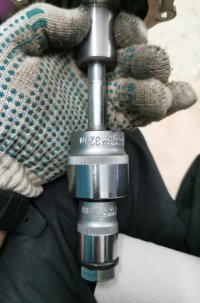
After removing it, I found rust. Is it dangerous?
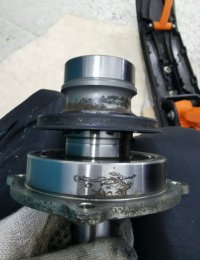
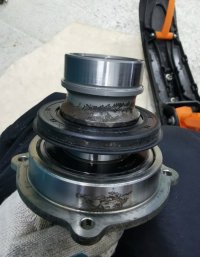
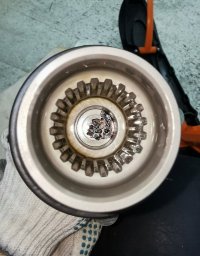
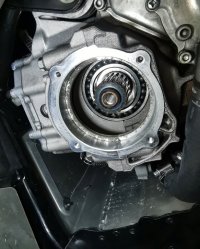
I'm going to change the bearings and install a new seal. It is also seen that the shaft and bearing have shifted.
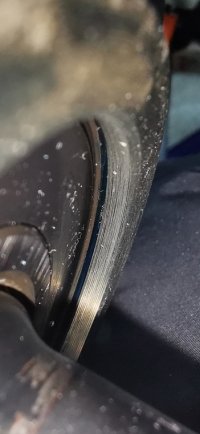

After removing it, I found rust. Is it dangerous?




I'm going to change the bearings and install a new seal. It is also seen that the shaft and bearing have shifted.

Last edited:
NYTurbo
TY 4 Stroke God
- Joined
- Sep 26, 2017
- Messages
- 1,562
- Reaction score
- 1,371
- Points
- 958
- Location
- Ottawa
- Country
- Canada
- Snowmobile
- Sidewinder
I don’t think I’d push it to 450 on stock internals. The block itself has issues over 500.They're really well designed and tough. Reportedly, the limit is about 450+ on stock internals, not that I would go there. But 250-300 seems to not be a problem otherwise like you said, we'd hear about failures.
Blowing belts ain't good for 'em for sure.
Sevey
TY 4 Stroke God
- Joined
- Feb 15, 2011
- Messages
- 1,787
- Reaction score
- 620
- Points
- 1,228
- Location
- Collingwood, ON
- Website
- www.ty4stroke.com
- Country
- Canada
- Snowmobile
- 2018 Sidewinder RTX
I have had a few stub assembly's out and they can corrode in some areas - around the inner housing and even in the inner part of the shaft with the splines (like your pic). Take some time while its apart and clean them up with a small wire brush. On the housing, i used the grinder with wire wheel.To remove the shaft, I used this method, it worked perfectly, like a reverse hammer. Two heads of 21 and 32 mm. So as not to spoil the bolt.
View attachment 174278
After removing it, I found rust. Is it dangerous?
View attachment 174273
View attachment 174274
View attachment 174275
View attachment 174276
I'm going to change the bearings and install a new seal. It is also seen that the shaft and bearing have shifted.
View attachment 174277
Normal - nothing to worry about. Does make you wonder about the condensation inside the motor.
When i have installed it back on - i will pack the splined area with grease so that internal area is well lubricated and no rust will form.
MS

Doc Harley
TY 4 Stroke God
- Joined
- Oct 17, 2016
- Messages
- 3,714
- Reaction score
- 1,815
- Points
- 1,413
- Location
- Here & there
- Country
- USA
- Snowmobile
- '17 Sidewinder LTX SE
Turboflash, can you remove shaft from brg to replace seal, while leaving brg in place inside housing? Just asking.


Turboflash
Lifetime Member
- Joined
- Mar 18, 2019
- Messages
- 2,756
- Reaction score
- 2,797
- Points
- 1,113
- Location
- Southern MN
- Country
- USA
- Snowmobile
- '17 ZR9000 Ltd. 137 - PEFI Stage 4
Yes but I wouldn't recommend. IMO there's a chance of moving the bearing when pressing off or on and you'd have to have a certain collar the right size to support bearing on inner race so you're not pressing through bearing to install stub back in.Turboflash, can you remove shaft from brg to replace seal, while leaving brg in place inside housing? Just asking.

Doc Harley
TY 4 Stroke God
- Joined
- Oct 17, 2016
- Messages
- 3,714
- Reaction score
- 1,815
- Points
- 1,413
- Location
- Here & there
- Country
- USA
- Snowmobile
- '17 Sidewinder LTX SE
I thought you might say that. Typically what is the life expectancy of that bearing.Yes but I wouldn't recommend. IMO there's a chance of moving the bearing when pressing off or on and you'd have to have a certain collar the right size to support bearing on inner race so you're not pressing through bearing to install stub back in.
Similar threads
-
This site uses cookies to help personalise content, tailor your experience and to keep you logged in if you register.
By continuing to use this site, you are consenting to our use of cookies.

